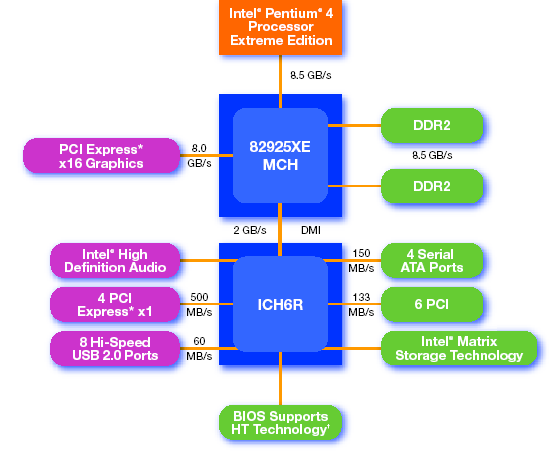925XE's workings
Chipset analysis is best complemented via a block diagram, so here we go.
1066MHz system bus
The 925XE all looks impressive enough. DDR2 memory is a forward-thinking measure, PCI-Express has now been adopted by a raft of AMD-based chipsets, high-definition audio sounds good, literally. But peruse the present 925X block diagram and play a game of spot-the-difference. It takes a keen eye to note that the only meaningful change has been in the bus speed between CPU and MCH. The 925X's stood at 6.4GB/s, running from an 8-byte 800MHz (200MHz quad-pumped, remember) bus speed. The 925XE, however, has bumped this up to 8.5GB/s, obviously gained from increasing the system bus speed up to 1066MHz. Motherboard makers will need to adopt new PLLs to support this fastest frequency. All in all, it's a minimal change for the likes of ASUS, MSI, et al.
The guts of the 925X have been carried over to form the 925XE, then. Intel has, it seems, simply validated certain 925X MCHs to operate at the faster speed and renamed them as 'XEs. Note that Intel highlights Extreme Edition CPUs are particularly suited to this performance-orientated core logic. We'll come to the 3.46GHz E.E in due time. So whilst there's not a whole lot that's new here, it's still prudent to take another look at the 925X/XE's capabilities as a complete chipset.
DDR2 memory
Now running in a synchronous nature to the CPU's Front-Side bus, dual-channel (2x64-bit) DDR2 RAM support remains at DDR533 speeds. Simple maths tells us that theoretical bandwidth is a system-matching 8.5GB/s. I very much think that DDR667 (10.6GB/s) speeds will be supported by most 925XE motherboard designers. The modules are already available from a number of prominent RAM manufacturers and having too much RAM bandwidth is never a bad thing, especially if overclocking. What's also exciting is how high-speed DDR2 latencies have slowly been coming down over the last month or so. Starting off with the i875P Canterwood, premium Intel dual-channel chipsets have been the recipient of PAT technology that reduces MCH latencies and supports ECC memory. That continues here, too.
PCI-Express graphics
As you would expect, PCI-Express has been carried over from the rest of the 900-series range. It's far more elegant than either AGP or PCI in a number of respects. High-speed peripheral connections such as FireWire and Gigabit Ethernet can swallow up PCI's 133MB/s bandwidth potential rather quickly. Get a few PCI-based ASICs together on a motherboard and bandwidth becomes a real concern. That's one reason why chipset designers have tried to amalgamate bandwidth-chewing devices on to south bridges. PCI-Express remedies this situation by using high-speed lanes capable of delivering up to 250MB/s of juicy bandwidth in each direction. Combine the lanes together, 16 in the case of graphics cards, and bandwidth becomes a moot point. The technology is eminently sound, so it's just up to peripheral makers to release PCIe devices.
Storage
Moving on down to the ICH6R south bridge through a bi-directional 1GB/s interconnect, we see that storage potential is as good as ever. 4 SATA ports, running on-chip and expandable to 6 via an external physical layer, support funky Native Command Queuing. NCQ is all about raising efficiency by re-ordering commands into the sequence that best fits what the controller asks for. Think of how fast a CPU operates. It's hella' quick. DDR533 system memory access isn't exactly a tortoise in the big scheme of things, either. Physical hard drive seeks are monumentally slower than either and if requests are picked up in the most efficient manner, through the use of NCQ, tangible performance gains are achievable.
To get some idea of what I'm talking about, try using an 80GB 5,400RPM hard drive and then a 74GB Western Digital Raptor one after the other. NCQ may not offer this much performance, but increasing the efficiency of the slowest system part, especially when being hammered by application data requests, is no bad thing. Matrix RAID technology makes the ICH6R that much more appealing. The ability to run two different RAID array over two drives boggles the mind with possibilities. The prominence of SATA relegates IDE to the background. Most 925X boards shipped with a single ATA interface that supported just two devices. Expect that trend to continue with retail 925XEs.
Sounds good
Long-term readers of HEXUS.net will know that we generally view on-board-generated sound with little glee. Most motherboards support the ageing AC'97 protocol and subsequently produce sound that's fine to notify you of an arrived email but leave you feel wanting in true high-fidelity terms. Another ICH6R improvement comes in the sound department. A bump in fidelity terms gives 8 (7.1) channels with sampling rates as high as 192KHz. All major home cinema audio standards are within Intel's high-definition audio's compass, including Dolby Digital and DTS. On the incumbent 925X chipset, we've often seen it paired up with Realtek's ALC880 CODEC. Expect this also to continue.
Then there's obvious support for the hard-to-define quality that is Hyper-Threading, present in all high-end Intel consumer-level processors. Pure benchmark numbers often gloss over the smooth multi-tasking feeling that HT tech affords. Put simply, a single processor is seen as two virtual CPUs by a HT-compatible operating system, such that two threads can be actioned in tandem: yum. Being a premium chipset that straddles home and workstation markets in equal measure, the 925XE also supports Intel's Extended Memory 64 Technology which, as the name sounds, supports 64-bit memory addressing. Note that you'll need special EMT64 processors and 64-bit OS's for it to function correctly.
In summary, Intel's 925XE chipset takes the present 925X Alderwood as a features' base and adds support for a 266MHz system bus speed. We can thus expect it to be a little quicker than Alderwood in most benchmarks. Intel is keen to point out that the 925XE is a balanced chipset that's suitable for a multitude of uses, ranging from high-speed networking, home cinema base and gaming goliath. I'd generally agree.









